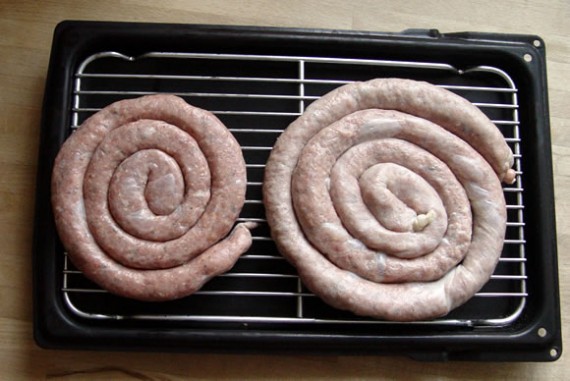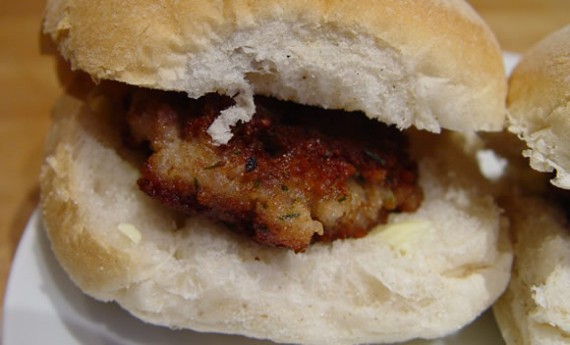Making sausages
If you are producing your own pig meat, you will almost certainly want sausages. Your butcher, if you are using one, will most likely be happy to make them for you and will charge accordingly for the additional time and the cost of the sausage skins. However, you may want to have a go at making your own.
Even if you aren’t keeping your own pigs, you may still want to make your own sausages too – then you can be sure of what goes into them and you can add herbs, spices and other flavourings to suit yourself.
 The first sausages we ever made!
The first sausages we ever made!
The most important ingredient of excellent sausages is excellent pork – so go for traditional, rare breeds, raised outdoors naturally.
You don’t need a lot of equipment to make sausages – in fact, a sharp knife to cut up the meat very small and a funnel to fill the skins will do but you would be better with a mincer and sausage stuffer.
We have a Kenwood Chef with a mincer and sausage stuffing attachment, which makes things much easier.
You can even do without the skins and make sausage meat burgers - we've done this very successfully in the past using a cheap burger press from Lakeland.
 Our sausage burgers.
Our sausage burgers.
Sausage casings
You have a choice of natural or manufactured casings:
- Natural casings are cleaned intestines, preserved in salt. Hog casings are the right size for traditional sausages, sheep casings for chipolatas. For salamis and dried sausages, larger casings are required – normally beef middles.
- Manufactured casings are made from animal collagen.
You will also need a chopping board, sharp knives, a measuring jug and scales. Make sure you have plenty of room in the fridge, too.
Good hygiene is very important, so make sure all surfaces and equipment are clean, that you have one, or preferably two, clean aprons (to protect the food from you, not the other way round) and clean hands.
- Previous « Wet-curing bacon

About Dan Champion
A self-confessed geek, Dan would spend 20 hours per day in front of a computer if he didn't live on a 12-acre smallholding in the east of Scotland (and if his wife would let him). He also built this website.
Further Reading
 Le Charcutier Anglais: Tales & Recipes of a Gamekeeper Turned Charcutier Berry Marc-Frederic |  Making Your Own Cheese: How to Make All Kinds of Cheeses in Your Own Home Paul Peacock |  Cheesemaking and Dairying: Making Cheese, Yoghurt, Butter and Ice Cream on a Small Scale Katie Thear |  The Sausage Book Paul Peacock |  Maynard: Secrets of a Bacon Curer Maynard Davies |













